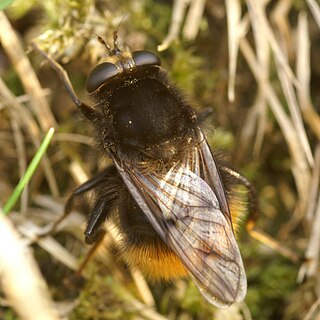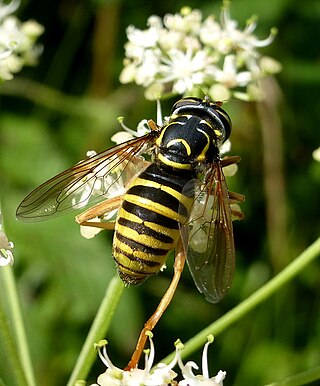
Nowickia is a subgenus of large flies in the family Tachinidae.

Spilomyia is a genus of hoverflies. Many species in the genus show Batesian mimicry of wasp models, including black and yellow patterns and modified antenna shape.

Ectophasia is a genus of flies in the family Tachinidae.

Lydina is a genus of flies in the family Tachinidae.

Criorhina is a genus of hoverflies. Medium to large sized species, black or greenish black, with or without light ground markings mimicking bumblebees. The head is much flattened and broader than the thorax. The antennae are situated upon a prominent conical frontal process, The face is moderately produced below the eyes, downward or forward, in profile. The eyes are bare. The abdomen is elliptical or very short oval. Larvae found in rot holes or decaying hardwoods

Chrysogaster is a genus of small hoverflies in the subfamily Eristalinae. They are dark or black with shiny colourful reflections and can often be seen visiting flowers in damp marshy areas where the aquatic larvae live. Species in the related genera Melanogaster, Orthonevra, Lejogaster and Riponnensia were formerly treated as members of Chrysogaster.

The Milesiini is a large and diverse tribe of hoverflies. They mimic wasps or hornets.
Palumbia is a genus of hoverflies from the family Syrphidae, in the order Diptera.

Criorhina ranunculi, is a species of hoverfly found in the spring in many parts of Britain and Europe.
Acemyini is a small but cosmopolitan tribe of flies in the family Tachinidae. Like all tachinid flies, acemyiines are parasitoids of other invertebrates. Specifically, the acemyiines are parasitoids of Orthoptera in the families Acrididae and Eumastacidae.

Phytomyptera nigrina is a European species of fly in the family Tachinidae.
Palumbia eristaloides is a species of hoverfly in the family Syrphidae.
Palumbia inflata is a species of hoverfly in the family Syrphidae.
Palumbia sinensis is a species of hoverfly in the family Syrphidae.
Palumbia tenax is a species of hoverfly in the family Syrphidae.
Palumbia vivax is a species of hoverfly in the family Syrphidae.
Palumbia pendleburyi is a species of hoverfly in the family Syrphidae.
Palumbia simulans is a species of hoverfly in the family Syrphidae.
Spilomyia digitata is a species of Hoverfly in the family Syrphidae.

Spilomyia manicata is a species of Hoverfly in the family Syrphidae.










